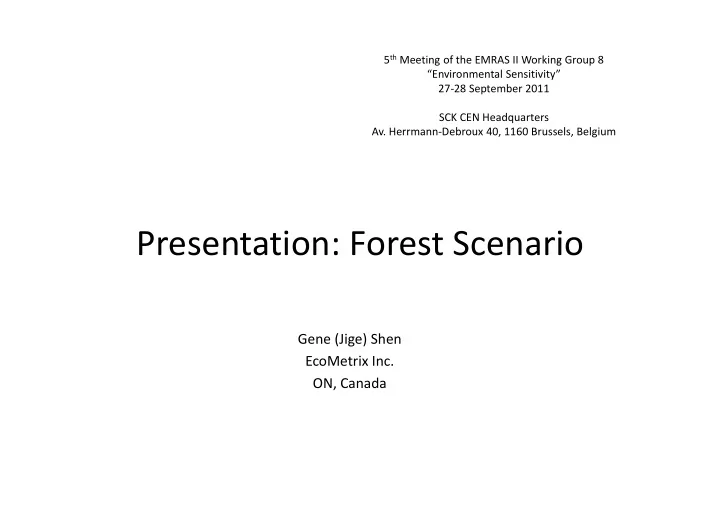

5 th Meeting of the EMRAS II Working Group 8 “Environmental Sensitivity” 27 ‐ 28 September 2011 SCK CEN Headquarters Av. Herrmann ‐ Debroux 40, 1160 Brussels, Belgium Presentation: Forest Scenario Gene (Jige) Shen EcoMetrix Inc. ON, Canada
Scenario Location
Scenario Setup
Considered Pathways 1
Considered Pathways 2
Scenario Assumptions Progenies: Y ‐ 90; Background radiation levels are neglected; Source loading assumptions: soil in mass basis (Bq/kg) and water in volume basis (Bq/L) Animal diet assumptions: all animals of interest are wild animals (no human feeds) and live in the site all year around (no migration) and only consume local foods. Human diet assumption: local residents live in the site 100% of time, plant and fish foods are from local produce, and 1/3 of adult intake meat and ¼ infant meat intake are from local meat sources.
Seasonal Variation The seasonal variation consideration: the baseline water flow on a monthly basis. Baseline Water Inflow 65 60 55 Flow rate (L/s) 50 45 40 0 0.2 0.4 0.6 0.8 1 Time (year) Animal dietary data are on annual average basis from CSA N288.1 ‐ 08. Annual averaged human dietary data are used: • Look at human doses at the end of certain years; • I ‐ 131 approaches to 0 after 2 months. Cs ‐ 137 and Sr ‐ 90 have effective half life of about 2 months. The human doses are hardly show difference due to the diet changes over seasons; • The human diet assumptions are already much conservative. To apply the seasonal diet variation doesn’t increase accuracy.
Human Dose (mSv/a) Total Dose after the fallout Total Dose after the fallout (log scale) 2.5 10 Adult Adult Infant_1y Infant_1y 2 1 Dose (mSv/a) Dose (mSv/a) 1.5 1 0.1 0.5 0 0.01 0 2 4 6 8 10 12 0 2 4 6 8 10 12 Time (year) Time (year) Adult Dose at 0 year Adult Dose at 1 year Terrestrial animals Terrestrial animals Terrestrial plants Terrestrial plants Aquatic animals Aquatic animals Aquatic plants Aquatic plants Sediment (external) Sediment (external) Pathways Pathways Sediment (ingestion) Sediment (ingestion) Soil (external) Soil (external) Soil (ingestion) Soil (ingestion) Cs ‐ 137 Cs ‐ 137 Water (external) Water (external) I ‐ 131 I ‐ 131 Water (ingestion) Water (ingestion) Sr ‐ 90 Sr ‐ 90 Air (external) Air (external) Y ‐ 90 Y ‐ 90 Air (inhalation) Air (inhalation) 0 0.2 0.4 0.6 0.8 1 1.2 0 0.005 0.01 0.015 0.02 0.025 0.03 Dose (mSv/a) Dose (mSv/a)
Animal Concentrations Mallard Concentrations Beaver Concentrations 600 25000 Cs ‐ 137 Cs ‐ 137 I ‐ 131 I ‐ 131 500 20000 Sr ‐ 90 Concentration (Bq/kg) Sr ‐ 90 Concentration (Bq/kg) 400 Y ‐ 90 Y ‐ 90 15000 300 10000 200 5000 100 0 0 0 2 4 6 8 10 12 0 2 4 6 8 10 12 Time (year) Time (year) Animal Cs ‐ 137 Concentrations • The whole body concentrations for 1.0E+05 “Hare”, “Loon”, “Muskrat”, “Vole”, Beaver Mallard 1.0E+04 “Scaup”, “Lynx”, “Mink”, “Wolf” are Caribou Concentration (Bq/kg) 1.0E+03 Moose available; Grouse • Animal rad doses and risk quotients 1.0E+02 can be calculated in the scenario. 1.0E+01 1.0E+00 1.0E ‐ 01 0 2 4 6 8 10 12 Time (year)
Plant Concentrations Blueberry Concentrations Labrador Tea Concentrations 1.4 1.4 Cs ‐ 137 Cs ‐ 137 1.2 1.2 I ‐ 131 I ‐ 131 Concentration (Bq/kg) Concentration (Bq/kg) Sr ‐ 90 Sr ‐ 90 1 1 Y ‐ 90 Y ‐ 90 0.8 0.8 0.6 0.6 0.4 0.4 0.2 0.2 0 0 0 2 4 6 8 10 12 0 2 4 6 8 10 12 Time (year) Time (year) The plants have two sources: soil and air. The soil source is the dominating source.
Fish Concentration Fish Concentrations 2500 Cs ‐ 137 I ‐ 131 2000 Concentration (Bq/kg) Sr ‐ 90 Y ‐ 90 1500 1000 500 0 0 2 4 6 8 10 12 Time (year) The fish concentration in fresh weight basis is in equilibrium condition with the water concentration assuming the water/fish reaches equilibrium instantly.
Soil Concentration • Assume the initial 1000Bq/m 2 Soil Concentrations ground activity uniformly 8 Cs ‐ 137 I ‐ 131 distributed over the top 10cm 7 Sr ‐ 90 Concentration (Bq/kg) 6 Y ‐ 90 layer. 5 • The dry bulk density is 1.6kg/L 4 • The water content is 0.15 3 2 That is: 1 The soil initial concentration is 0 7.35Bq/kg (dry weight basis). This 0 2 4 6 8 10 12 value applies to Cs ‐ 137, I ‐ 131, Sr ‐ Time (year) 90 and Y ‐ 90.
Water/Sediment Concentrations Water Concentrations Sediment Concentrations 0.8 300 Cs ‐ 137 Cs ‐ 137 0.7 I ‐ 131 250 I ‐ 131 Sr ‐ 90 0.6 Concentration (Bq/kg) Concentration (Bq/L) Sr ‐ 90 Y ‐ 90 200 0.5 Y ‐ 90 150 0.4 0.3 100 0.2 50 0.1 0 0 0 2 4 6 8 10 12 0 2 4 6 8 10 12 Time (year) Time (year) • Assume the pond water 1000Bq/m 2 is applied to all water depth; • The water depth is 1.5m; • Assume the sediment has no initial activity at time 0 from the fallout event. That is: • The initial water concentration is 0.667Bq/L. This applies to Cs ‐ 137, I ‐ 131, Sr ‐ 90 and Y ‐ 90; • The sediment initial concentration is 0.
Air Concentration Outdoor air Concentrations 1.4E ‐ 07 Cs ‐ 137 I ‐ 131 1.2E ‐ 07 Sr ‐ 90 Concentration (Bq/m 3 ) Y ‐ 90 1.0E ‐ 07 8.0E ‐ 08 6.0E ‐ 08 4.0E ‐ 08 2.0E ‐ 08 0.0E+00 0 2 4 6 8 10 12 Time (year) The air concentration is in equilibrium condition with the soil concentration by a soil re ‐ suspension process.
Recommend
More recommend